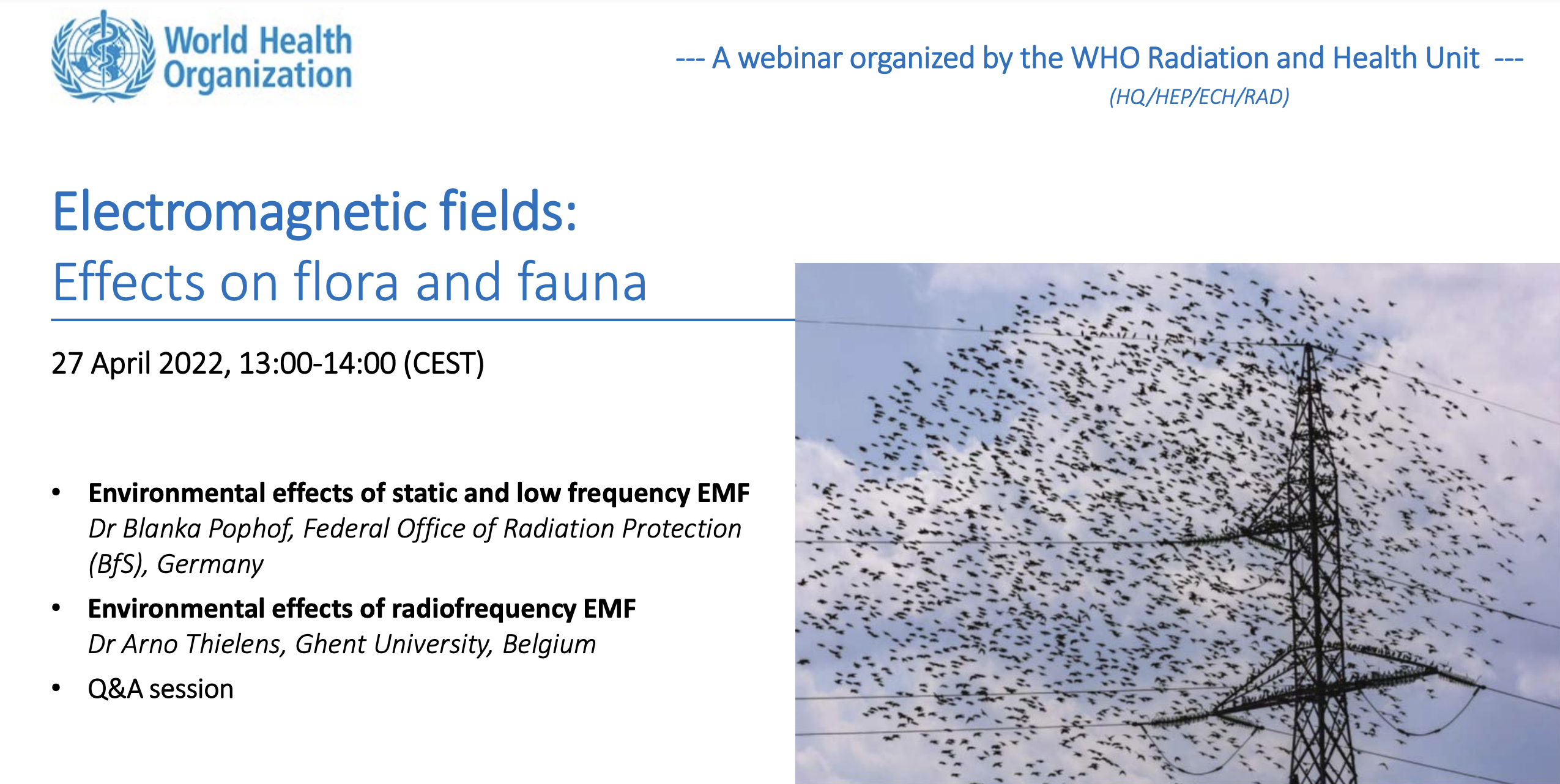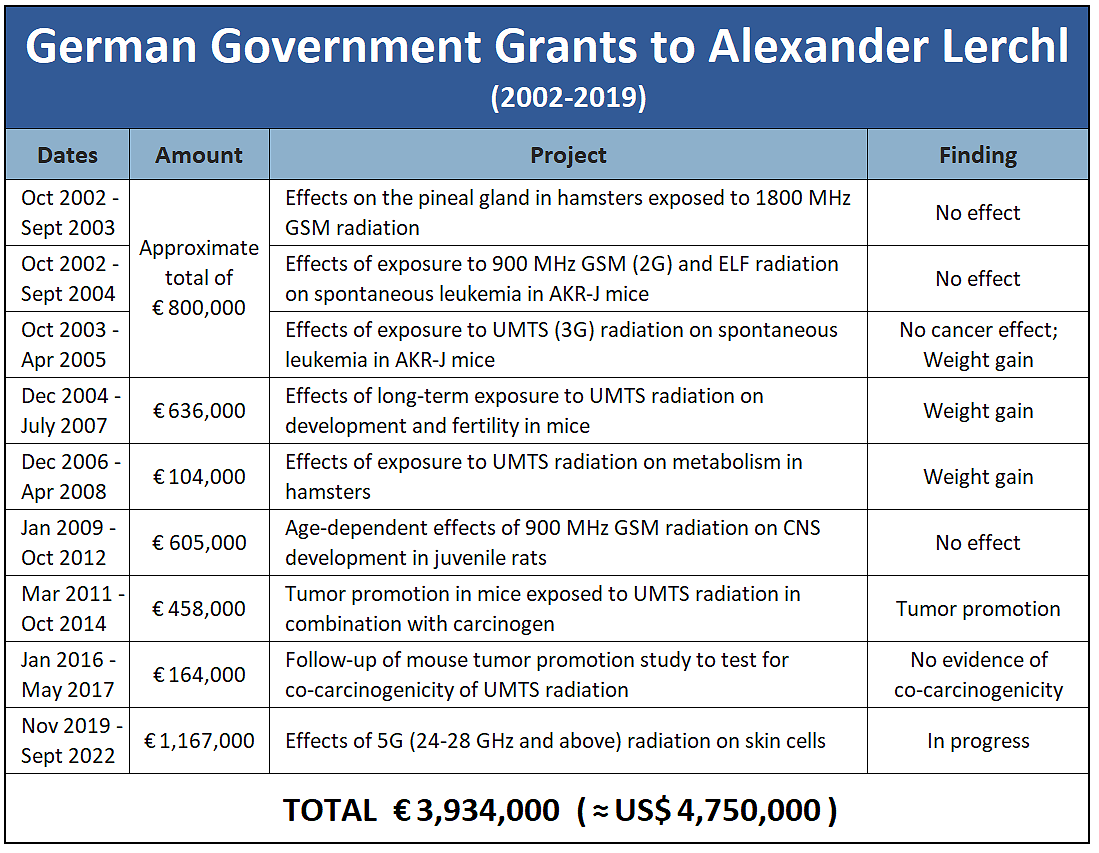News Center: Short Takes Archive
Forty Years Later, Not Much Has Changed
A Challenge to ICNIRP
Close to 40 years after its first publication, The Microwave Debate, Nicholas Steneck’s history of research and regulation of microwave health effects, is back in print —this time in Norwegian.
The new translation comes with an epilogue by Thomas Butler, a professor at Ireland’s Cork University Business School, who has contributed seven chapters —about 30,000 words— to bring Steneck’s history up to the present.
The centerpiece of Steneck’s story is how the microwave exposure limit, known as the 10 milliwatt or Schwan standard, came about in the mid-1950s and continued to hold sway for decades. A four-member team, led by Steneck, published “The Origins of the U.S. Safety Standards for Microwave Radiation” in Science magazine in 1980.
Butler continues this thread with a focus on how the standard evolved after 1984, and the parts played by ICNIRP, the IEEE and the FCC.
The translation is the brainchild of Einar Flydal, formerly with Telenor, a telecom conglomerate serving the Nordic and many other countries. He has also been a consultant to the Norwegian Ministry of Education and an adjunct professor at the Norwegian University of Science & Technology (NTNU). After retiring in 2011, Flydal turned to speaking and blogging on EMF/RF health issues, including dirty electricity, smart meters, and most recently 5G. He lives in Oslo.
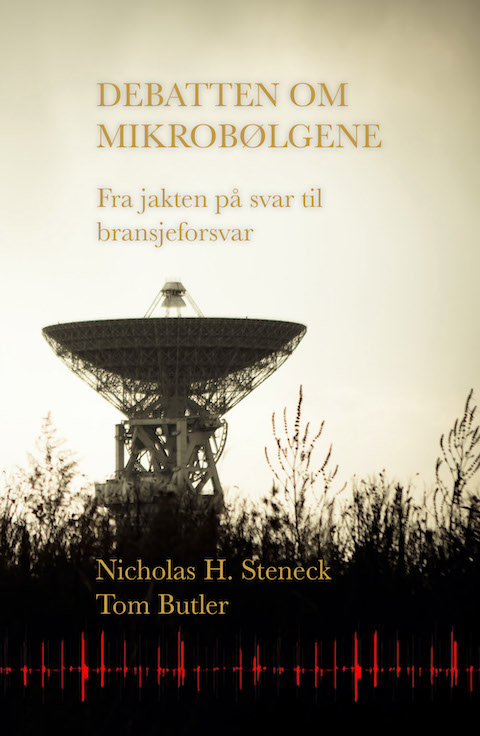
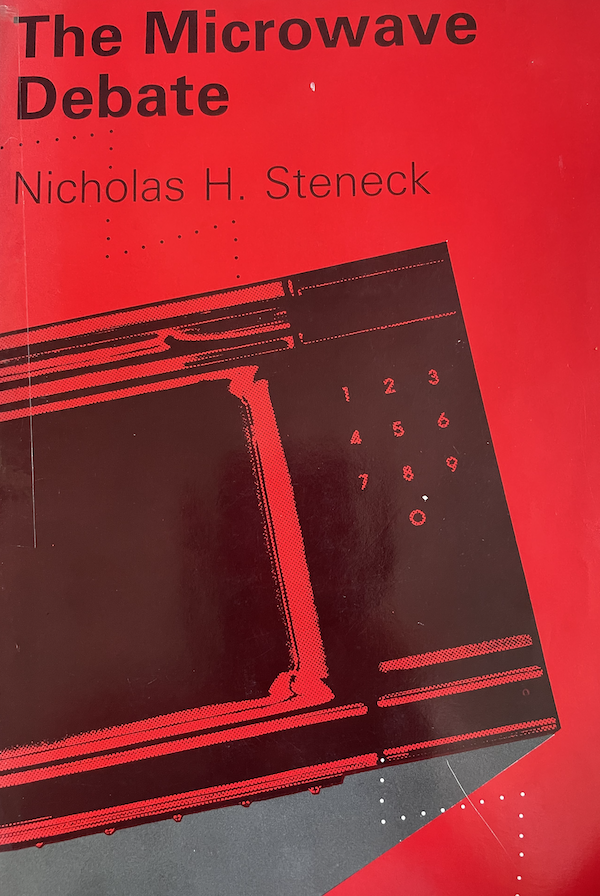
The Norwegian (2022) and the original U.S. (1984) editions
Asked why he had undertaken the translation, Flydal explained that as he was digging into EMF history he became fascinated by the work of Robert Becker and Andrew Marino, two biophysicists who, separately and together, wrote a number of books. Becker’s The Body Electric, which came out in 1985, a year after Steneck’s Debate, is considered a classic. It’s still in print.
Along the way, Flydal spotted a reference to The Microwave Debate and how it offered details on the origin of the U.S. exposure limit. Last year, he located a copy in a second-hand bookstore in San Diego. “I quickly realized that while it may be out of print, it’s not out of date,” Flydal told me. “I then spent most of the winter translating.” He also reached out to Butler, who, like himself, is highly critical of ICNIRP: Butler has described the Commission as carrying the torch “to protect the thermal view.”
Flydal said that the translation was worth the effort. The potential audience is larger than one might assume, he explained. “All Scandinavians can read Norwegian —although Swedes and Danes find it a bit odd. Icelanders can too.” (The total population of these four countries is over 22 million.)

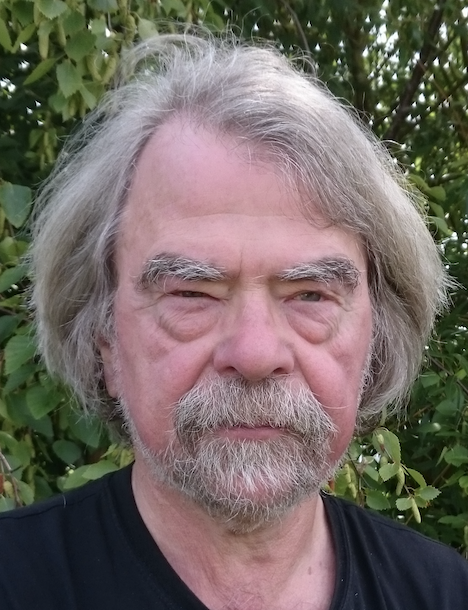
Tom Butler Einar Flydal
Unlike Steneck, who presents a largely neutral description of microwave history, Butler is an advocate for change. He sees what has transpired over the last 40 years as ample grounds for a new approach, one that does not include ICNIRP.
ICNIRP: “An Immoral Group”
“In my opinion,” Butler stated in an email from Cork, “ICNIRP is an immoral group of scientists who knowingly distort scientific truth to protect industry interests over the public good.” He added: “Given the weight of evidence on oxidative stress, and the ubiquity of wireless devices in homes, we may be looking at an increase in chronic and systemic illnesses.” Butler describes himself as a social scientist and technologist.
Flydal’s new book has received an improbable endorsement from Lars Klæboe of the Norwegian Radiation Protection Authority. He calls it a “formidable effort.” This blurb on the back cover is surprising in the ever-polarized world of RF and health. Klæboe, a member of the original Interphone study group, is skeptical of RF health risks. He has long worked with Maria Feychting, a former vice chair of ICNIRP, and Joachim Schüz of IARC, two other skeptics.
Butler is planning a “much slimmed down” version of his epilogue, some 8,000 words, for publication in an English-language journal.
Neither Butler nor Flydal is a stranger to the political machinations of the RF world —and of course there’s a lot about that in Steneck’s book.
A couple of years ago, Butler filed a complaint against the Irish Times after the newspaper reprinted an article from the New York Times: “The 5G Health Hazard That Isn’t,” by William Broad. Butler charged that Broad had distorted the facts and the Irish Press Ombudsman agreed. The NY Times shrugged it off. (More on Broad’s distortions here: “A Fact Free Hit on a 5G Critic.”)
Flydal recently published —with Else Nordhagen— an analysis showing that ICNIRP’s 2020 RF/MW exposure limits are based on scientific reviews by a small clique, most of whose members have close ties to ICNIRP itself (they call this “self-referencing authorships”). Nordhagen and Flydal detail how Their paper was posted by Reviews on Environmental Health on June 27.
Steneck was a history professor at the University of Michigan in Ann Arbor when the Microwave Debate was published in 1984. After becoming emeritus, he became a consultant in the field of scientific integrity.
I asked Steneck for some thoughts about where the Debate stands today. Here’s part of what he told me:
“In the book, I showed that science was influenced by values and politics, but that message was not accepted. So now, 40 years later, we are still relying on ‘science’ to make decisions, not realizing or admitting that the RF field is plagued by the same problems that existed in the 1980s. When contacted about the translation, I was pleased to know that some understood and appreciated what drives and shapes the research we use to set policies. I am not optimistic that this new translation and update will make much of a difference. Today’s social media generation will not tolerate any limitation of 5G.”
_______________________
Debatten on Mikrobølgene is available online and in local bookstores with a list price of 460 NOK (US$45), though Flydal says it can usually be had for 410 NOK ($40).
Runs over 200 Pages and Includes More Than 1,000 References
WHO Webinar on ELF EMF and RF Effects on F&F
A detailed examination —likely the most exhaustive ever attempted— of the environmental effects of non-ionizing radiation has been published in Reviews on Environmental Health.
“Effects of Non-Ionizing Electromagnetic Fields on Flora and Fauna” is in three parts, the last of which was posted today. They are:
- Part 1. Rising Ambient EMF Levels in the Environment
- Part 2. Impacts: How Species Interact with Natural and Man-Made EMF
- Part 3. Exposure Standards, Public Policy, Laws, and Future Directions
Taken together, the three papers run over 200 pages in the journal and include more than 1,000 references.
The authors are Blake Levitt, Henry Lai and Albert Manville. Levitt is a science journalist, based in Connecticut, and the author of Electromagnetic Fields: A Consumer's Guide to the Issues and How To Protect Ourselves, first published in 1995. Lai is a professor emeritus at the University of Washington, Seattle. In the 1990s, he and N.P. Singh were the first to show that ELF (60 Hz) EMFs and RF radiation could lead to DNA breaks. Manville is a lecturer at Johns Hopkins University in Baltimore and, formerly, a wildlife biologist with the U.S. Fish and Wildlife Service.
“We approached it from the biology/environmental ecosystem level, rather than the typical physics and/or human physiology side,” Levitt told Microwave News.
She added that they are planning to publish a book on the topic for the lay reader.
WHO Webinar: EMF Effects on Flora & Fauna
April 21, 2022
The World Health Organization (WHO) will host a webinar on April 27 on Electromagnetic Field Effects on Flora and Fauna. There is no charge for listening in, but you must register by April 26. The one-hour session will be recorded and made available to those who register.
The speakers will be Blanka Pophof of the German Federal of Radiation Protection (BfS) and Arno Thielens of Ghent University in Belgium.
May 2, 2022
A video recording of the one-hour webinar has now been posted. Go to:
http://bit.ly/39yaFzt
and use passcode:
6Fn#pDVS.
A transcript is also available.
Fourth Paper by Levitt, Lai and Manville
November 25, 2022
Today, Levitt, Lai and Manville published a new paper (their fourth) of EMF/RF effects on wildlife and plants in Frontiers of Public Health.
They write: “Long-term chronic low-level EMF exposure guidelines, which do not now exist, should be set for wildlife... We have a long overdue obligation to consider potential consequences to other species... The evidence requiring action is clear.”
This new paper is open access. Here’s the abstract:
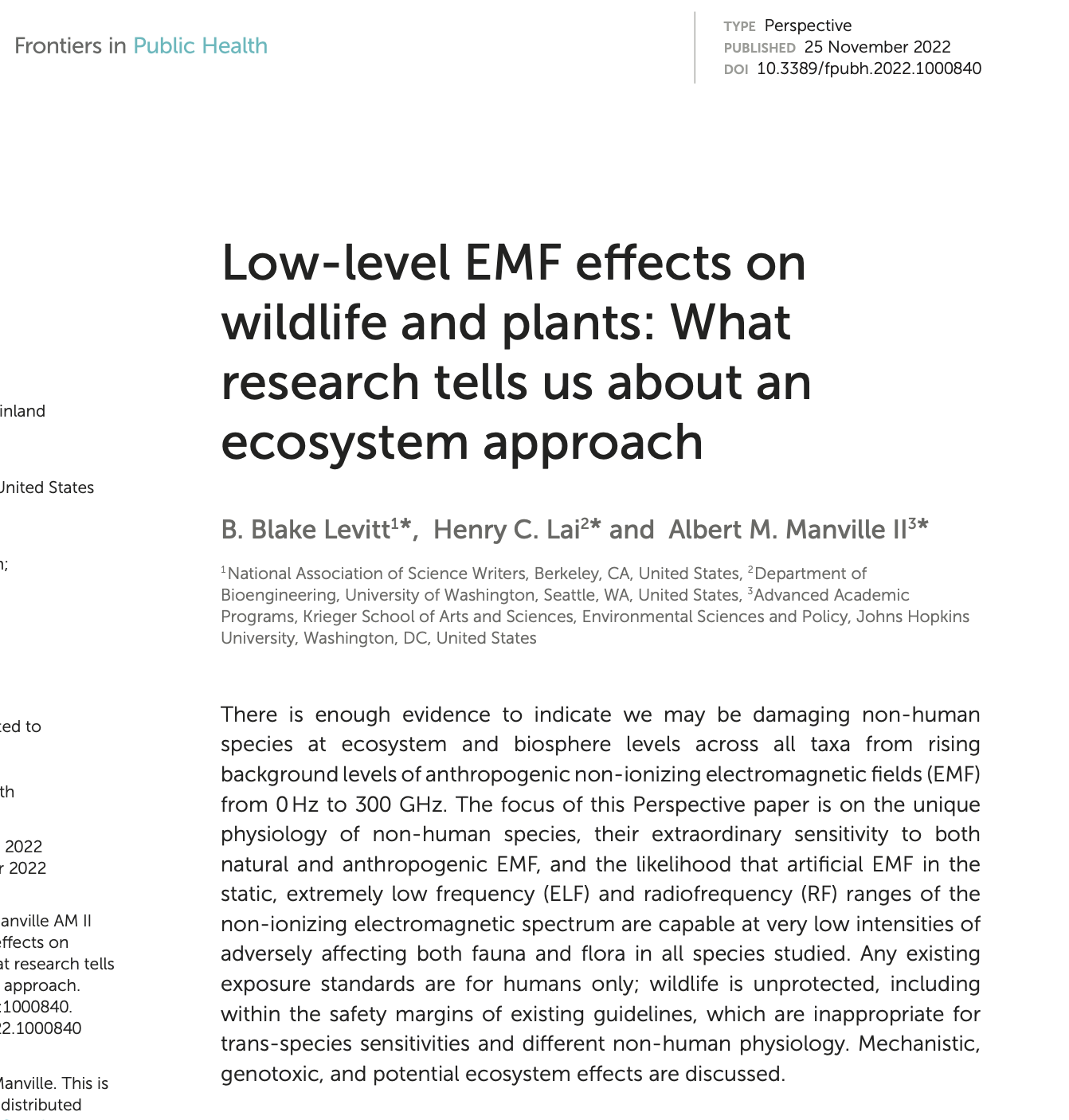
Alexander Lerchl Has Received $5 Million in Research Grants from German Government
Alexander Lerchl’s bogus campaign against the REFLEX project and members of Hugo Rüdiger’s lab did nothing to harm his career. Just the opposite, Lerchl thrived as he gained stature and a succession of rich research grants from the German government.
Over the last 20 years, Germany’s Federal Office of Radiation Protection —the Bundesamt für Strahlenschutz, or BfS for short— has given Lerchl $5 million in contracts. Lerchl has been the best-funded RF lab researcher in Germany, Europe, and, most likely, the world (see Table below).
“Invalidating the REFLEX study and showing that mobile phone radiation is harmless are in the interest of his patrons —the BfS and the mobile communication industry,” Franz Adlkofer told Microwave News. “Both have embraced him.” Adlkofer ran the REFLEX project and supported Elisabeth Kratochvil’s lawsuit against Lerchl that led to his censure in a December court decision (see accompanying story).
The BfS is also the principal sponsor and institutional home of the International Commission on Non-Ionizing Radiation Protection (ICNIRP). In each of the last three years, it has contributed 70-80% of ICNIRP’s annual income. Like Lerchl, ICNIRP has refused to recognize, and has often dismissed, the cancer risks associated with mobile phones.
In 2008, as he was waging his campaign against the Rüdiger lab, Lerchl was appointed to a two-year term as chairman of the Non-Ionizing Radiation Committee of the German Radiation Protection Commission, known as the SSK, and was reappointed in 2011. For four years, 2009-2012, Lerchl was, effectively, the most senior advisor on EMFs and RF radiation to the German government. (The SSK advises the BfS.)
As early as May 2013, the directors of Diagnose:Funk, a German-Swiss environmental and consumer protection group, issued a public statement calling for Lerchl to be disavowed by the BfS management and other scientific, governmental and academic officials. They asked:
“For how long is this man still to be tolerated by the scientific community as a research project leader, by the Jacobs University Bremen as a tenured professor, and by politicians as an advisor?”
In an interview with Diagnose:Funk, posted online on February 4, Adlkofer echoed those same eight-year-old sentiments. Politicians “must ask themselves whether they can afford to continue working with a man who has been exposed as an unscrupulous slanderer,” Adlkofer stated.
Lerchl Silent on BfS’ Two Failed REFLEX Follow-Ups
In 2005, the BfS sponsored two projects to test the REFLEX findings. Both were beset with missteps and delays.
The first was a million-dollar (€832,000) contract to a young researcher, Petra Waldmann, at the College of Applied Sciences in Darmstadt. It appeared to be an obvious attempt to engineer a negative finding. Waldmann was tasked with using a cell type that Rüdiger and Kratochvil had already shown to be unresponsive to mobile phone radiation. At the time, Adlkofer had warned the BfS that “you won’t see an effect” with those cells. She didn’t. Inexplicably, Waldmann took seven years to publish her negative results in Radiation Research.
To save face the BfS soon commissioned a second project, also in Darmstadt, at a cost of $700,000 (€566,000) which called for exposing the same type of cells (lymphocytes) in which Rüdiger had seen DNA breaks. No effects were found. These results are not easily accessible. They were never published in a peer-reviewed journal and the final report was not released for six years —not until 2014, eight years after the first Rüdiger paper. The report runs 268 pages and is available in German only, with a one-page abstract in English.
Amid his never-ending criticism of REFLEX, Lerchl came to see himself in the role of policing the EMF/RF literature to weed out what he saw as bad science and misconduct. Yet, he never once called out either group of Darmstadt researchers, or his benefactors at the BfS when they decided to use an inactive cell type, or when the Darmstadt group failed to publish its findings.
Importantly, Lerchl never acknowledged that a 15-minute walk from the Rüdiger lab, across the MUV campus, Wilhelm Mosgöller’s group was exposing the same cells to the same radiation and seeing changes in DNA repair. That is, Mosgöller was showing independent evidence of the claim at the heart of the Vienna controversy: RF radiation can affect DNA (more here).
Lerchl is a professor of biology at Jacobs University. He also has an appointment as a professor of ethics of science and technology.
Slow-Walking Cancer Studies
In 2011, while Lerchl was still chairman of the SSK NIR committee, the BfS awarded him over $500,000 (€458,000) for an animal experiment to repeat a German study which showed that 3G radiation can promote cancer. To just about everyone’s surprise, in 2015, Lerchl announced that he had confirmed the earlier finding.
A replication study has always been held as the sine qua non for regulatory action. Yet, BfS remained silent. It called for no reevaluation of the RF–cancer risk. Nor is there any indication that the BfS asked ICNIRP to investigate.
The BfS followed up with another contract, this time for $200,000 (€164,000), to allow Lerchl to see if he could better understand how RF promotes tumors. Though it ended in May 2017, Lerchl only published his findings late last year.
By then, the BfS had given Lerchl yet another contract, this time for close to $1.5 million (€1.2 million) for work on 5G radiation. News of this award was not without irony. Lerchl, who was known as an animal researcher, would now be following up Rüdiger’s cell culture studies. He would be doing the experiments that Adlkofer had lost due to the fallout of the Vienna Affair.
In a statement following the Bremen decision, Diagnose:Funk urged the BfS to cancel Lerchl’s 5G contract.
Others have called on Japanese and Korean officials to remove Lerchl from the advisory panel for the partial repeat of the U.S. NTP animal-cancer study.
See also: German Court Moves To Silence Relentless Critic of RF DNA Studies
and Lerchl’s Unattainable Prize: The IARC RF Panel
Cited Theory To Reject Low-Level EMF Effects
Robert K. Adair, the former chairman of the physics department at Yale University and a leading critic of any and all claims that weak EMFs can have biological effects, died on September 28. He was 96.
A particle physicist, Adair held one of Yale’s prestigious Sterling professorships. He was a member of the National Academy of Sciences. To the public, Adair is best known as the author of The Physics of Baseball.
During the 1990s, after retiring from teaching, he took a professional interest in the work of his wife, Eleanor Adair, who studied the physiological effects associated with microwave heating at the John B. Pierce Laboratory, also in New Haven (and later at Brooks Air Force Base in Texas). Over the next decade, Robert Adair published a series of scientific papers and commentaries, in which he maintained that, as he wrote in a 1992 letter to Science magazine, health risks associated with exposure to weak EMFs are an “imaginary problem.”
One of Adair's central arguments was that low-level fields could not affect biological systems because they are so much weaker than the natural thermal fluctuations in living systems (this is known as the “kT problem”). He once compared worrying about EMF health effects with being concerned that a cat will damage a tree by breathing on it during a howling wind storm.
In a letter to Physics Today in 1991, he wrote that “good scientists” consider very weak 60 Hz fields harmless “because their effects on the cellular level are very, very much smaller than thermal noise.” Earlier that same year, he presented his argument in a 10-page paper in the Physical Review under the title, “Constraints on Biological Effects of Weak Extremely-Low-Frequency Electromagnetic Fields.” He also published his views on EMFs in the Proceedings of the National Academy of Sciences. See, for instance, this 1994 paper on interactions with magnetite.
Adair had influential allies within the Yale physics community, notably Allan Bromley, who was also a Sterling professor and a chairman of its physics department. Bromley was the science advisor to President George H.W. Bush. In 1990, Bromley delayed the public release of an EPA report that classified power-frequency EMFs as a probable human carcinogen and microwave radiation as a possible carcinogen. Those cancer classifications were removed from the report prior to release and never officially acknowledged or acted on.
Frank Barnes, for one, has publicly disagreed with Adair. In an interview with Microwave News in 2016, Barnes said: “Bob Adair’s calculations are not wrong — they just don’t deal with the situations we are dealing with,” referring to the potential for RF radiation to promote cancer. Barnes is a distinguished professor emeritus of electrical engineering at the University of Colorado in Boulder and a long-time member of the National Academy of Engineering.
Eleanor Adair died in 2013 at the age of 86.
The Yale Department of Physics has posted an obituary for Robert Adair, under the title, “Explorer of Strange Particles —and Baseballs.” A shorter obit appeared in the New Haven Register.
Don’t Use Millimeter Band Pending More Research
An advisory panel to the Health Council of the Netherlands is recommending a “cautious approach” to 5G radiation exposures.
The committee is also advising that the 26 GHz frequency band (millimeter waves) not be used “for as long as the potential health risks have not been investigated.”
The new advisory report, 5G and Health, was originally released in September with an executive summary in English. Now a full 131-page translation is available (it features 807 references). There is also a 33-page overview.
The nine-member panel, all from Holland, was chaired by Professor Hans Kromhout, an epidemiologist at the University of Utrecht’s Institute for Risk Assessment Sciences. One of the two scientific secretaries is the Health Council’s Eric van Rongen, the current vice chair of ICNIRP and its chairman from 2016 until earlier this year.
While the committee endorses the recently revised ICNIRP guidelines, it notes that, “[I]t cannot be excluded that exposure under the latest ICNIRP standards also has the potential to affect health.”
Here is the full text of the committee’s four recommendations to the Dutch Parliament:
1. Because the lower frequency bands for 5G (up to 3.5 GHz) have already been used for telecommunications applications and Wi-Fi for years without resulting in any proven adverse health effects, the committee sees no reason to stop or restrict the use of these frequency bands. It does however recommend that the exposure should be monitored before, during and after the rollout of the 5G systems. This will make clear to what extent exposure to radiofrequency electromagnetic fields changes as a result of the introduction of 5G and any long-term health risks can then be estimated better. The WHO analysis can also be used in estimating the risks.
2. The committee recommends doing more research:
• epidemiological research into the relation between exposure to the 5G frequencies used and the incidence of cancer, reduced male fertility, poor pregnancy outcomes and birth defects. An ongoing international study into the use of mobile telephones, in which the Netherlands is participating, can play a role in this.
• experimental research into the health effects of exposure to electromagnetic fields in the 26 GHz frequency band.
• scenario studies to get a picture of the exposure of individuals as a result of wireless communication systems (3G, 4G and 5G).
3. The committee recommends not to use the 26 GHz frequency band for 5G for as long as the potential health risks have not been investigated.
4. Finally, the committee recommends using the latest guidelines from the International Commission on Non-Ionising Radiation Protection (ICNIRP) as the basis for exposure policy in the Netherlands. Because it cannot be excluded that exposure under the latest ICNIRP standards also has the potential to affect health, the committee recommends to take a cautious approach and keep exposures as low as reasonably achievable.
Senior FDA Radiation Official Challenged Adequacy of RF/MW Exposure Limits in the 1970s
“A safe level of microwave exposure was arbitrarily established —no dissent from the arbitrary safe standard was tolerated— in a largely thermal (i.e., high-exposure level) microwave research program … [It] and the averaging provisions … may represent a directed verdict rather than a culmination of objective and unbiased scientific judgment.”
Does that sound familiar?
Actually, it’s from a paper delivered more than 40 years ago by Moris Shore, the former director of the Division of Biological Effects at FDA’s Bureau of Radiological Health. Yesterday the Washington Post revealed that Shore died of kidney disease on July 1 at the age of 92.
In the quote above, Shore was referring to the U.S. 10 mW/cm² ANSI standard adopted in 1974, which, in turn, was an update of the 1957 and 1966 limits. He charged that it “ignored a substantial body of published scientific findings that documented low-level biological effects.”
The current IEEE standard evolved from these same 1957/1966/1974 standards. It is a direct descendant.
Shore also pointed out that the 1974 standard was much weaker than those adopted by two large corporate contractors. For example, GE’s limits were 10 times more stringent and those of Bell Telephone Labs were 100 times stronger. Both companies had set their internal standards in the 1950s, but later accepted the looser limits under pressure from the military, even though there was little new research.
Shore made these remarks in a paper presented at the 10th Annual National Conference on Radiation Control, held in Harrisburg, PA, in the spring of 1978.
________________________
Here is the full text of the announcement in the Post:
Moris Shore, FDA scientist
Moris Shore, 92, a retired Food and Drug Administration public health scientist who studied biological effects and health implications of radiofrequency and microwave radiation exposure, died July 1 at a hospital in Bethesda, Md. The cause was kidney disease, said his son, Michael Shore.
Dr. Shore helped establish industry performance standards on electromagnetic radiation emissions from electronic products and conducted research on the association between prenatal diagnostic X-ray exposure and childhood leukemia. He worked for several federal agencies during his career, including the FDA from 1971 to 1985, when he was deputy director of the Office of Science and Technology in the Center for Devices and Radiological Health.
He also helped organize a visiting scientist program at the FDA and, in retirement, served as a consultant to the Pan American Health Organization and the law firm Fried, Frank, Harris, Shriver and Jacobson in Washington.
Ken Foster & Niels Kuster Disagree on Averaging Times
Very little has been written in the popular media about the waveforms used in 5G signals. Two outstanding questions are: How fast are the pulses? How powerful are they?
In 2018, Esra Neufeld and Niels Kuster of the IT’IS Foundation in Zurich issued a warning in a paper in Health Physics, urging that existing exposure standards be revised with shorter averaging times to address potential thermal damage from short and strong pulses:
“Extreme broadband wireless devices operating above 10 GHz may transmit data in bursts of a few milliseconds to seconds. Even though the time- and area-averaged power density values remain within the acceptable safety limits for continuous exposure, these bursts may lead to short temperature spikes in the skin of exposed people. ... [Our] results also show that the peak-to-average ratio of 1,000 tolerated by the ICNIRP guidelines may lead to permanent tissue damage after even short exposures, highlighting the importance of revisiting existing exposure guidelines.”
In a letter to the journal, Kenneth Foster* of the University of Pennsylvania countered that their claims do not hold up:
“Because real-world communications technologies produce pulses of much lower fluence than the extreme pulses considered by Neufeld and Kuster, the resulting thermal transients from them will be very tiny in any event.”
Neufeld and Kuster’s response to Foster is here.
(Keep in mind that as the averaging time increases, radiation peaks smooth out and compliance with exposure limits becomes easier.)
FCC Proposes Shorter Averaging Times
In its proposed revision of its own RF rules, issued last December, the U.S. FCC appeared to side with Kuster, expressing concern over the many wireless devices that “transmit in short bursts.” Here is part of what the FCC stated:

The FCC put forward shorter averaging times for signals at higher frequencies —dropping down to 1 second above 95 GHz. These are detailed in the table below. In contrast, the averaging times in the ICNIRP and IEEE standards are as high as 25 minutes.

Now, the wireless industry is asking the FCC to favor Foster’s views over Kuster’s. Last week, a team from the Mobile & Wireless Forum (MWF) —formerly known as the Mobile Manufacturers Forum (MMF)— held a virtual meeting with members of the FCC’s Office of Engineering and Technology (OET) and lobbied for the withdrawal of the proposed new averaging times.
The PowerPoint slides of MWF’s presentation are here and its cover letter to the FCC is here. (Chuck Eger, who signed the letter, was formerly in Motorola’s Washington office. He mistakenly used old MMF letterhead.)
Members of the MWF include Apple, Huawei and Samsung. Foster’s research has been supported by the MWF.
Will the FCC formalize the new averaging times in its final RF rules, or follow the MWF request and scrap them? Stay tuned.
______________________
* For more on Ken Foster’s work on this issue, see these two recent papers; both are open access:
• Kenneth R. Foster, Marvin C. Ziskin, Quirino Balzano and Akimasa Hirata, “Transient Thermal Responses of Skin to Pulsed Millimeter Waves,” IEEE Access, 2020;
• Kenneth R. Foster, Marvin C. Ziskin, Quirino Balzano and Akimasa Hirata, “Thermal Analysis of Averaging Times in Radiofrequency Exposure Limits Above 1 GHz,” IEEE Access, 2018.
Each paper acknowledges the support of the MWF.
Q. Balzano, a coauthor of the two papers, is a member of the board of the IT’IS Foundation. In their 2018 Health Physics paper, Neufeld and Kuster acknowledge Balzano for his “insights and guidance on emerging wireless communication systems.”
This article is adapted from a thread of seven tweets posted by Microwave News yesterday. If you are not yet following Microwave News on Twitter, give us a try, @microwavenews.
DARPA’s New ICEMAN Project Seeks Answers
Spatial disorientation among U.S. Air Force pilots has been linked to 72 severe accidents between 1993 and 2013, resulting in 101 deaths and the loss of 65 aircraft. Now DARPA, the defense department’s Advanced Research Projects Agency, wants to know whether RF radiation in the cockpit of combat aircraft may be at least partly to blame.
Under the new initiative, with the acronym ICEMAN, DARPA is seeking a contractor to measure the electromagnetic fields inside cockpits, especially signals between 9 kHz and 1 GHz and then determine whether they might affect the performance of pilots. ICEMAN is short for Impact of Cockpit Electro-Magnetics on Aircrew Neurology.
In its request for proposals, DARPA states that, “Current cockpits are flooded with RF noise from on-board emissions, communication links, and navigation electronics, including strong EM fields from audio headsets and helmet tracking technologies.” The agency notes that current tactical audio headsets project magnetic fields that are up to 10 times the strength of the Earth’s magnetic field —that is, approximately 5 G (0.5 mT). DARPA continues:
“Recent DARPA-funded research has demonstrated that human brains sense magnetic fields, like those used by animals for navigation, and that this process is ‘jammed’ (i.e., disrupted) by radio waves (RF), impacting brainwaves and behavior. Furthermore, recent findings were the first to show that even weak RF fields and ‘Earth strength’ magnetic fields have measurable, reproducible effects on human brainwaves and unconscious behavior in a controlled environment.”
The “recent research” refers to work carried out under DARPA’s RadioBio program, announced in 2017. One of its objectives was to see whether living cells can communicate with neighboring cells using EM signals and, if so, what the cells are telling each other and how they do it.
Joe Kirschvink at Caltech, a RadioBio contractor, has reported that human brain waves respond to changes in magnetic fields on the order of the Earth's field.
According to DARPA, the objectives of the ICEMAN project are:
1) Measure and manipulate the ambient EM field and RF noise in a typical cockpit;
2) Measure potential effects of EM stimuli on brain activity, physiology, behavioral responses and physiological sensing systems;
3) Demonstrate potential strategies to mitigate negative effects on aircrew neurology and sensory function.
The deadline for proposals is October 5.
More on the how DoD defines major aircraft accidents, here.
Iceman was the nom de guerre of a fighter pilot played by Val Kilmer in the movie Top Gun.
Provided 70-80% of Its Support in Each of Last Three Years
The German government is the main sponsor of ICNIRP, the International Commission for Non-Ionizing Radiation Protection.
The Federal Ministry for the Environment, Nature Conservation and Nuclear Safety (BMU), which is the bureaucratic parent of the Federal Office for Radiation Protection (BfS), has contributed 70-80% of ICNIRP’s annual income in each of the last three years. This does not include revenue from the sale of books and fees to attend workshops.
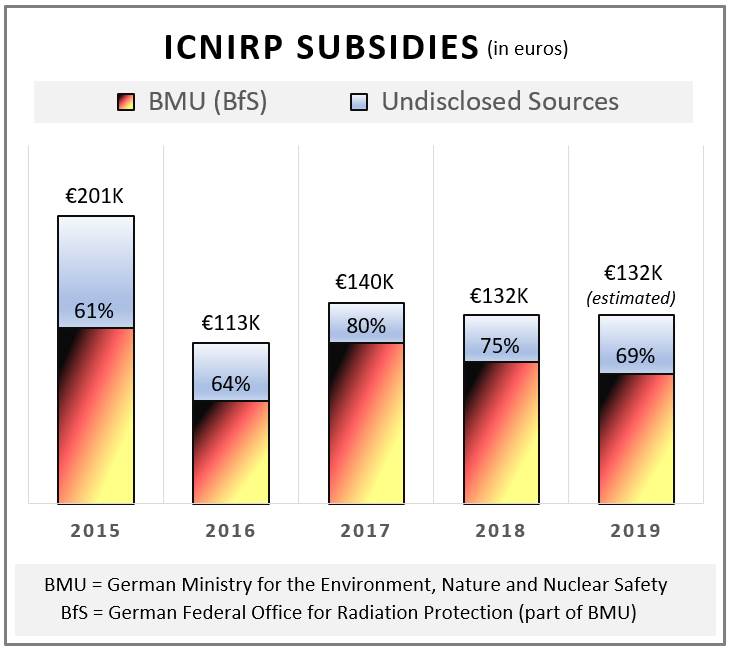 Sources: BMU and ICNIRP
Sources: BMU and ICNIRP
The BMU/BfS has been known to support ICNIRP, but the extent of its funding has only now emerged.
Details of Germany’s support for ICNIRP was provided to Microwave News by the BMU following an information request.
ICNIRP also receives an “in-kind-contribution” from the BMU: “free” office space in the BfS premises in Oberschleiβheim, near Munich, according to Bastian Zimmermann, a BMU spokesperson.
Among the other agencies that support ICNIRP are: European Union Programme for Employment and Social Innovation “EaSI” (2014–2020), International Radiation Protection Association (IRPA), Australian Radiation Protection and Nuclear Safety Agency (ARPANSA) and New Zealand Ministry of Health.
ICNIRP, originally an offshoot of IRPA, was launched in 1992, at the initiative of Michael Repacholi, who at the time was with the Australian Radiation Laboratory (see MWN, J/A92, p.12). He served as ICNIRP’s first chairman until 1996, when he moved to become the head of the WHO EMF Project, which he also helped set up (see MWN, J/A96, p.14).
ICNIRP develops exposure guidelines which are the basis for many national standards, including Germany’s. It releases an annual report, but specifics about its finances are sketchy at best.
First Update Since 1998
The International Commission on Non-Ionizing Radiation Protection (ICNIRP) has issued updated guidelines for exposures to RF/microwave radiation.
“The guidelines have been developed after a thorough review of all relevant scientific literature, scientific workshops and an extensive public consultation process. They provide protection against all scientifically substantiated adverse health effects due to EMF exposure in the 100 kHz to 300 GHz range,” according to Eric van Rongen, the chairman of ICNIRP.
“We know parts of the community are concerned about the safety of 5G and we hope the updated guidelines will help put people at ease,” he said. Van Rongen is with the Health Council of the Netherlands.
The new guidelines are published in Health Physics and are open access. A copy is available here. They were last updated in 1998.
The ICNIRP press release is here.
_______________
See also our recent article on the links between the World Health Organization (WHO) and ICNIRP:
“Will WHO Kick Its ICNIRP Habit?”
and
“How Much Is Safe?: Radiation Authorities Rely on Controversial Group for Safety Advice” from Investigate Europe,

